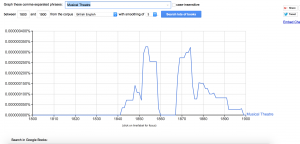According to this ngram chart, there was a rise in Musical Theatre in Victorian England, specifically between 1840-1860 and 1870-1875, with major spikes in 1874 and 1853. Now according to branch collective.org, that chart activity has a lot to do with play activity o the east end. For example in 1847 (according to Sharon Aronofsky Weltman, of branch collective.org), Victorian playwright, George Dibdin Pitt wrote the first Sweeney Todd dramatization for Brittanica of London’s east end and fit the melodrama to the specific audience and the acting to the company’s individual talents.” Also, in the winter of 1942, a man named John Curwen started “Tonic Sol-fa” which is a method to teach singing. Curren thought that this”would improve individual and national morality” and later in the century, this had come to help a thousands of singers practice, and even began to compete with singing by means of sight-reading and “promoted a way of managing behavior that worked alongside rational recreation and newly introduced institutional surveillance strategies.”-Phyllis Weliver. So the awareness of new plays, and new singing methods created a type of interest in musical theatre. Keeping up with the trend of seeing shows on the East End since they were very popular was a big part of life. As stated above, in the excerpt about Sweeney Todd, the script was tailored to a specific audience, which in the east end was populated mainly by working class and impoverished individuals. The victorian english loved to be entertained, and specifically enjoyed gory spectacles and freak shows, which in that case, would make Sweeney Todd a very popular, and a very heavily demanded production on the east end. So whatever shows were suited exceptionally well for that type of audience would create a spike in the popularity of musical theatre at the time. Tt really depended on what shows were being put on or put out then.
